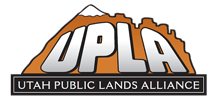Many of our treasured public lands in the state of Utah are going a variety of management planning revisions at this time or will be soon within the coming year. Current, active plans include the Bears Ears National Monument Resource Management Plan and the San Rafael Swell Travel Management Plan. For an overview of current and upcoming active plans, check out this article that provides an overview of those that are slated within the next several months.
The American people collectively own all public lands. They are one of the most valuable endowments of our citizenship, wherein every American may enjoy the rich beauty and vast array of natural and cultural resources that our public lands embody. Through the direction of the US Congress, various federal and state agencies like the Bureau of Land Management (BLM) and US Forest Service are designated to manage our public lands for the benefit of the American people. Agencies like the BLM and Forest Service do not own our public lands, they are merely responsible to manage it. Thus, as citizens, it is our right and responsibility to help direct each agency in public land management by participating in the planning process. Anyone who enjoys recreation or use of public lands for activities like off-roading, camping, horseback riding, hiking, mining, etc., must provide their input during the planning process to ensure that access to public lands for such purposes is prioritized and protected as management decisions are made.
In order for us to be effective as we participate in public land management planning, it is important to understand the goals and purpose of different types of plans. For example, right now we have the opportunity to provide public comment on a Resource Management Plan (for Bears Ears National Monument), and we’ll soon have the same opportunity to comment on a Travel Management Plan (for San Rafael Swell). What is the difference between a Resource Management Plan (RMP) versus a Travel Management Plan (TMP). RMPs and TMPs serve different but complementary purposes.
A Resource Management Plan is a comprehensive document that outlines the long-term management goals and strategies for a specific area of public land, such as a national forest, park, or wildlife refuge. RMPs typically address a wide range of natural and cultural resources, including wildlife habitats, water quality, vegetation, archaeological sites, scenic values, and recreational opportunities. These plans are often developed through a collaborative process involving stakeholders, agencies, and the public to ensure that multiple interests and perspectives are considered. RMPs provide guidance for land managers in making decisions about resource use, conservation, development, and restoration within the designated area. RMPs are intended to function like a 30,000-foot overview; they solely address management structure at a programmatic level, creating guidelines and guardrails for future site-specific and trail-specific plans. Per directives from Congress (36 CFR 212), RMPs do not make site-specific decisions regarding travel management because travel management decisions are made at the project level.
A Travel Management Plan focuses specifically on the management of motorized and non-motorized travel within a given area of public land. TMPs are developed to address issues related to off-road vehicle use, hiking, biking, horseback riding, and other forms of recreational travel. These plans aim to balance the public’s interests for recreational access with the need to protect natural and cultural resources, minimize conflicts among user groups, and ensure public safety. TMPs often involve the designation of specific routes, trails, and areas for different types of travel, as well as the implementation of regulations and enforcement measures to manage recreational use responsibly.
While RMPs focus on the broader management of natural and cultural resources, TMPs specifically address the management of recreational travel activities within a designated area of public land. Both types of plans are important tools for protecting public access to public lands, while ensuring the sustainable and responsible management of our treasured public lands for current and future generations. While it is of critical importance for outdoor recreation enthusiasts to participate in the planning process, it is equally important that we understand the goals and purposes of each plan to ensure that our public comments are effective, that the BLM, Forest Service, or other management agency actually uses our comments to shape the final decision for each plan. Increasingly, it is also critical that we hold managing agencies accountable to ensure that site-specific and trail-specific decisions are addressed solely within TMPs, and not implemented within RMPs.
Over the last several years, a disturbing trend in public land management planning is that public access and recreational uses take a backseat in priority in the planning process; an extreme environmentalist agenda is elevated in many public land management decisions. One example of this is the recent TMP that was implemented for the Labyrinth Rim & Gemini Bridges area near Moab. This is just one example, there are many more. Thus, our mission at UPLA is to inform and equip you to join in the effort to preserve public access to public lands for all forms of outdoor recreation. We offer resources and support to make it easy for you to participate in public land management planning, and to stay up-to-date on current plans that are open for public comment. We invite you to join us in the effort to protect public access to our nation’s beautiful public lands!
Rose Winn
Utah Public Lands Alliance
Natural Resource Consultant
Rose@UtahPLA.com









